Did you know that Vermont is the second smallest state by population after Wyoming? Despite this, the Green Mountain State is home to more than 250 bird species, including songbirds, crows, hummingbirds, and more.
Those birds vary in behavior, color, migration patterns, diet preferences, and more. Some of these birds are so common that you might come across them in other states. Others are rare enough that you may need to go on a special hiking adventure to see them.
In this article, we’ll showcase 20 birds in Vermont that you may be lucky enough to stumble upon if you live in or intend to visit the lovely state.
Let’s dive in!
Red Birds in Vermont
American Robin
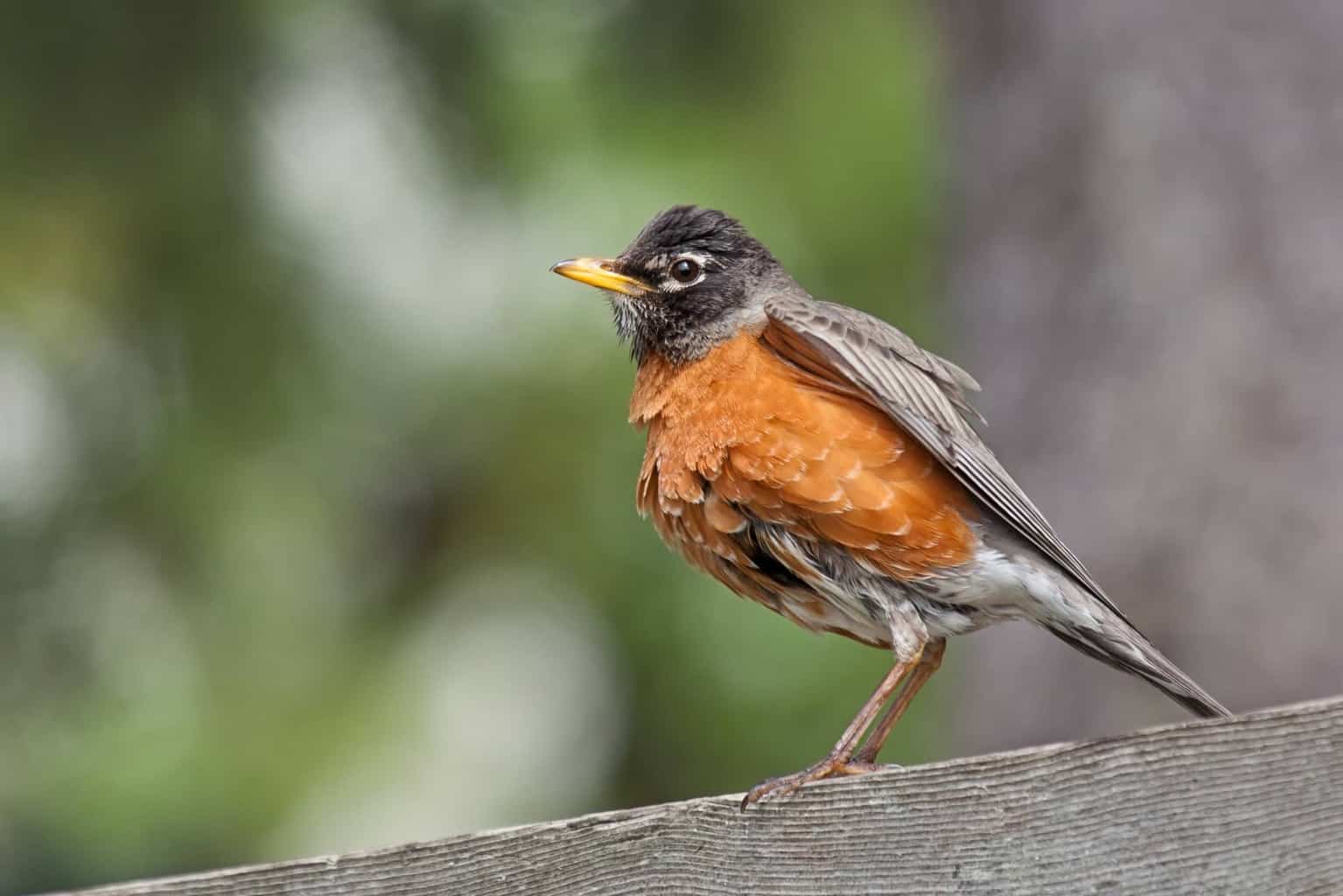
- Scientific name: Turdus migratorius
- Length: 7.9 – 11.0 inches
- Weight: 2.7 – 3.0 ounces
- Wingspan: 12.2 – 15.8 inches
Let’s start our list with one of the most common red birds in the state of Vermont. The American robin is fairly easy to spot because it doesn’t mind the company of people. Therefore, you might see one in open woodlands, fields, or even in your backyard.
American robins are also a breeze to tell apart from other bird species thanks to their rusty-red breasts and dark heads. If you get closer to one, you might also notice white splotches around the eyes.
Males and females don’t look much different from each other, but females tend to be paler in color.
The American robin’s diet mainly consists of worms, insects, snails, and the like. It doesn’t say no to fruits, either. Unfortunately, American robins don’t care much about bird feeders because they don’t eat seeds, so it may be tricky trying to attract one to your yard.
Northern Cardinal

- Scientific name: Cardinalis cardinalis
- Length: 8.3 – 9.1 inches
- Weight: 1.5 – 1.7 ounces
- Wingspan: 9.8 – 12.2 inches
The Northern cardinal is another bird that Vermont is known for. Unlike the faded red of the American robin, the Northern cardinal’s red coloration is more saturated. This bird’s body is rounder, too, with a black mask and throat.
The females of this bird species have a whole different coloring. They’re a rather orange tint of brown with faded red on their wings and tales.
The best thing about cardinals is that they’re open to bird feeders, so inviting them to your backyard is easy. They love peanuts, sunflower seeds, and corn.
Scarlet Tanager
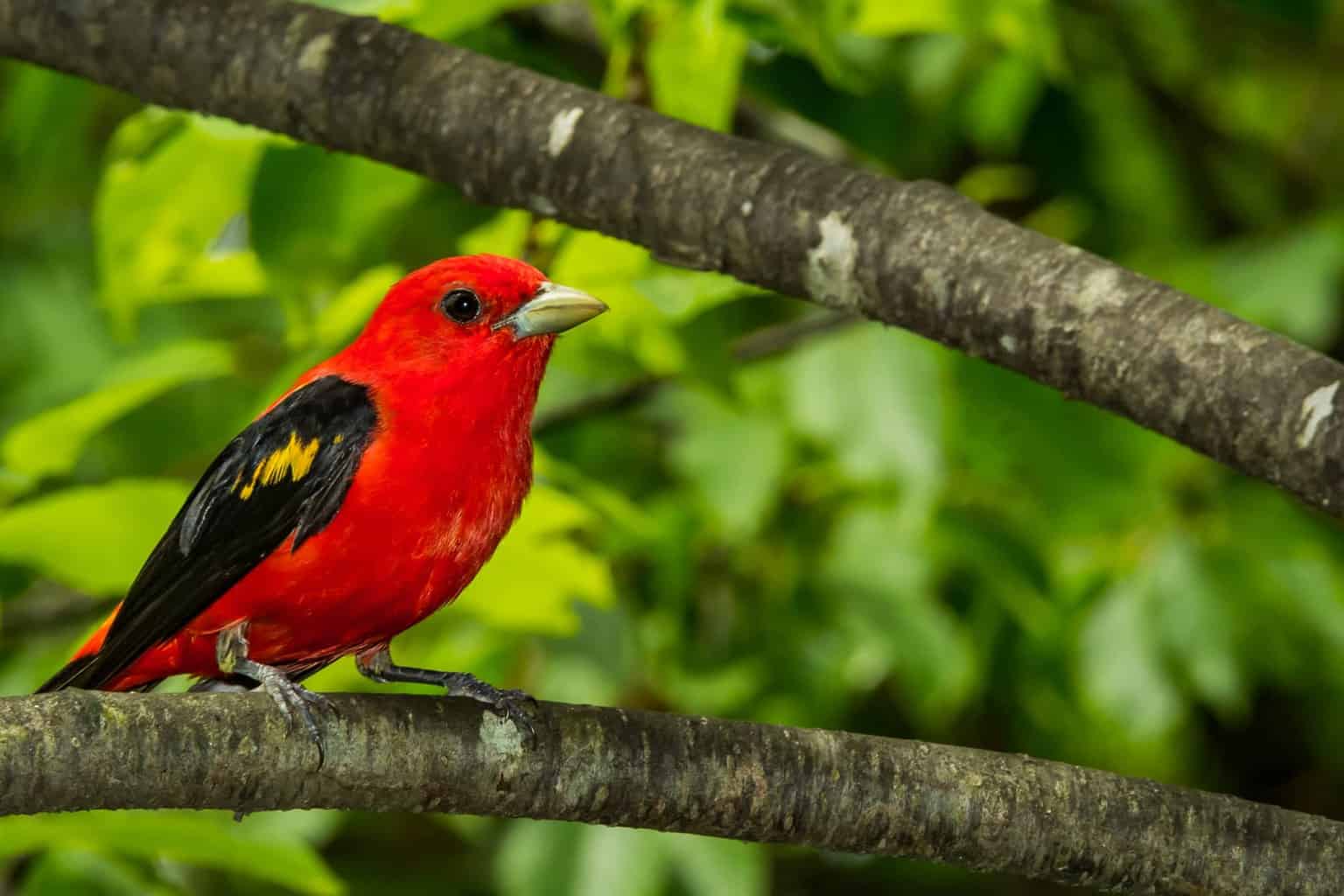
- Scientific name: Piranga olivacea
- Length: 6.3 – 6.7 inches
- Weight: 0.8 – 1.3 ounces
- Wingspan: 9.8 – 11.4 inches
Although this bird isn’t rare or endangered, it’s pretty tough to see a Scarlet tanager as you’re running errands. This beautiful creature prefers to stay deep within the evergreen forests in eastern North America. If you ever wish to see one, it’s time to pack your bags for a hike.
The Scarlet tanager requires no great effort to recognize. The males have brilliant red bodies with black wings and tails. On the other hand, females and non-breeding males lean towards olive-yellow.
After adult males breed, their feathers turn yellow, too, but they keep their black parts. Pretty interesting, don’t you think?
Scarlet tanagers like to feed on insects in the summer. When they migrate in winter, they also don’t mind including different types of fruit in their diet.
Red-Headed Woodpecker

- Scientific name: Melanerpes erythrocephalus
- Length: 7.5 – 9.1 inches
- Weight: 2.0 – 3.2 ounces
- Wingspan: 16.5 inches
The Red-headed woodpecker is pretty common across eastern North America, especially in Vermont. Even better, these eye-catching birds are found in many habitats. They live in wetlands, open forests, pine plantations, tree rows, and more.
Plus, identifying an adult Red-headed woodpecker is simple, thanks to its bright-red head and black-and-white body. Juvenile birds have gray-brown heads instead, with rows of black spots on the wings.
Like all types of woodpeckers, the Red-headed woodpecker uses its strong, sharp bill to hammer at wood to capture insects. Not just that, this glorious bird can also catch its tiny prey in flight and on the ground. Talk about a talented hunter!
Blue Birds in Vermont
Blue Jay

- Scientific name: Cyanocitta cristata
- Length: 9.8 – 11.8 inches
- Weight: 2.5 – 3.5 ounces
- Wingspan: 13.4 – 16.9 inches
When we talk about blue birds, the Blue jay instantly comes to mind. This medium-sized bird is native to eastern North America and is easy to spot if you live in Vermont. However, many people consider Blue jays pests because they’re pretty noisy.
The males and females of this species look the same. They both have blue-colored backs with black bars weaved in, white underparts, and black necklaces. They’re also best known for the stunning blue crests on top of their heads.
Blue jays are a breeze to attract to your backyard. Simply fill your bird feeder with sunflower seeds or corn.
Eastern Bluebird
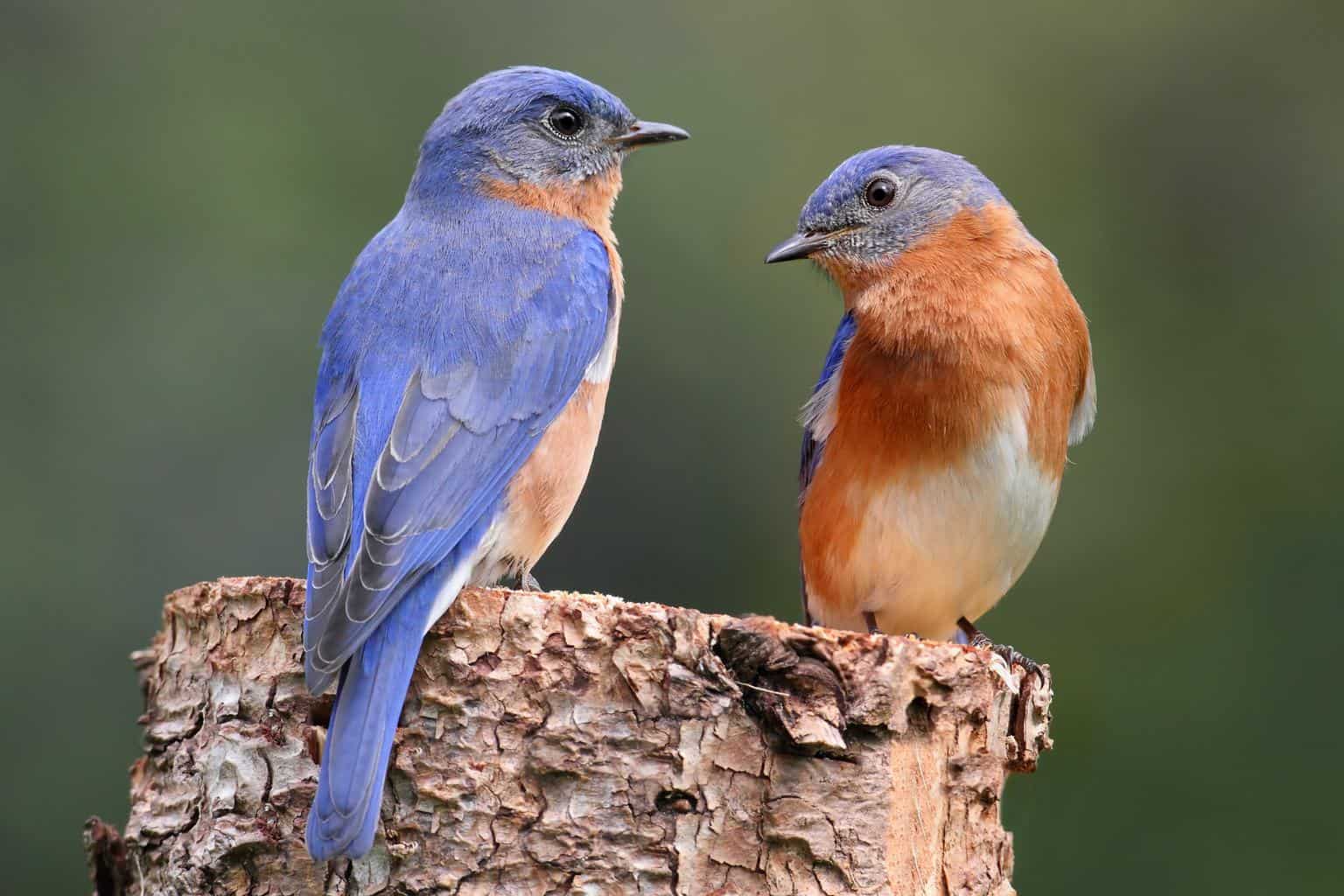
- Scientific name: Sialia sialis
- Length: 6.3 – 8.3 inches
- Weight: 0.95 – 1.20 ounces
- Wingspan: 9.8 – 12.6 inches
The Eastern bluebird is another vibrant bird that you might find in Vermont. It’s easy to identify thanks to its blue wings, head, and upperparts. It also has a brown collar around its head.
The greatest thing about the Eastern bluebird is that it can be found in a wide range of habitats. You might see one in open woods, farmlands, orchids, and gardens. Plus, it may just pay your backyard a visit if you offer irresistible food.
The Eastern bluebird is a huge fan of seeds, berries, and small fruits. Yet, its diet mainly consists of insects such as grasshoppers, beetles, and crickets.
Tree Swallow
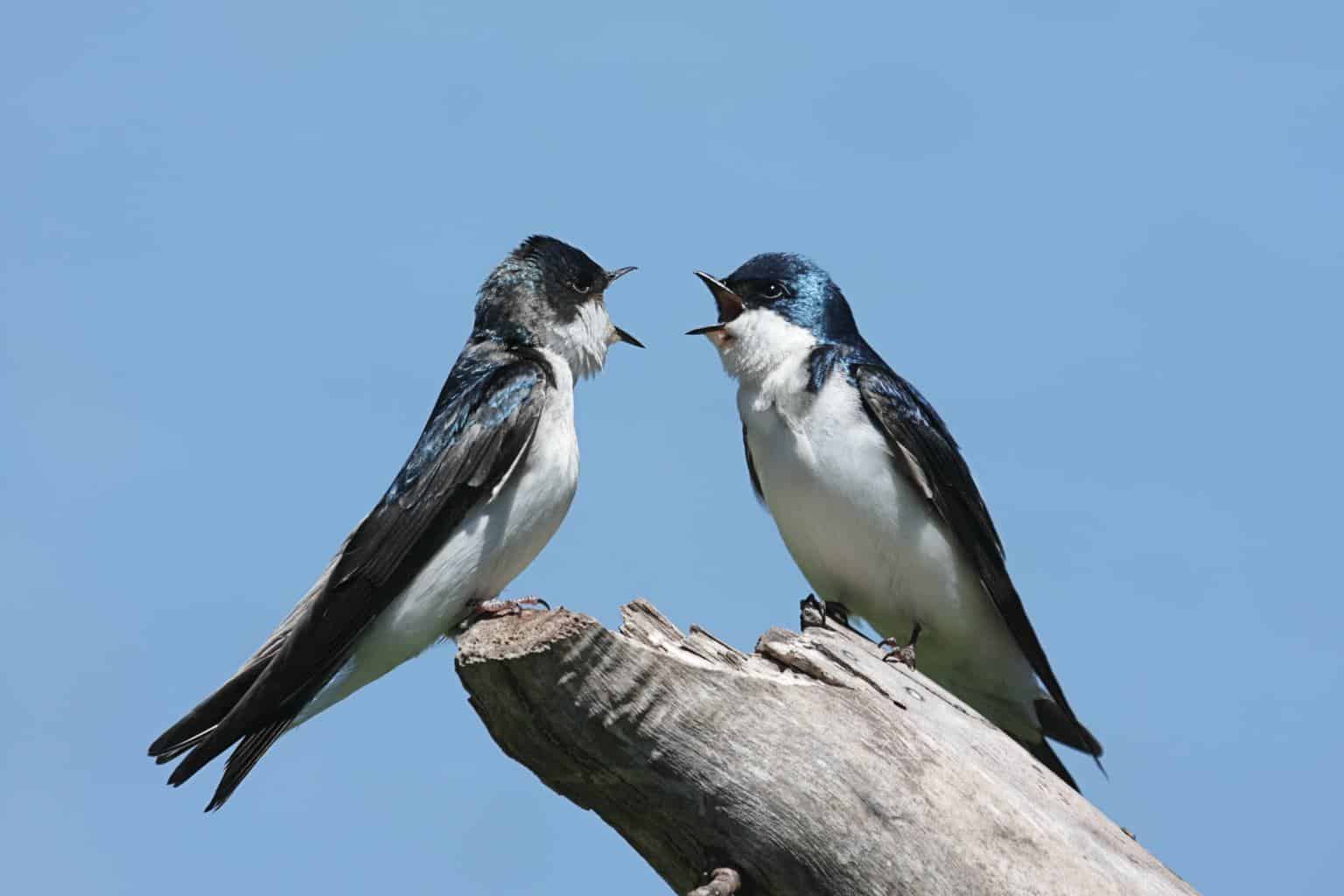
- Scientific name: Tachycineta bicolor
- Length: 4.7 – 5.9 inches
- Weight: 0.6 – 0.9 ounce
- Wingspan: 11.8 – 13.8 inches
The Tree swallow is one of the smallest birds you can come across in Vermont. Yet, size isn’t the only thing remarkable about this beautiful bird. Its stunning blue and white plumage is an instant eye-catcher, which is good news for enthusiastic bird watchers.
However, according to bird watchers in Vermont, this bird has an observation frequency of only 10% every year in the state. This is because Tree swallows are constantly on the move, but they’ll stay in Vermont from April to September.
If you hope to see one in your yard during this time of the year, you’d better fill your feeder with nuts and small seeds. When Tree swallows aren’t feeding on seeds or small fruits, they’ll eat larvae, worms, and insects.
Indigo Bunting
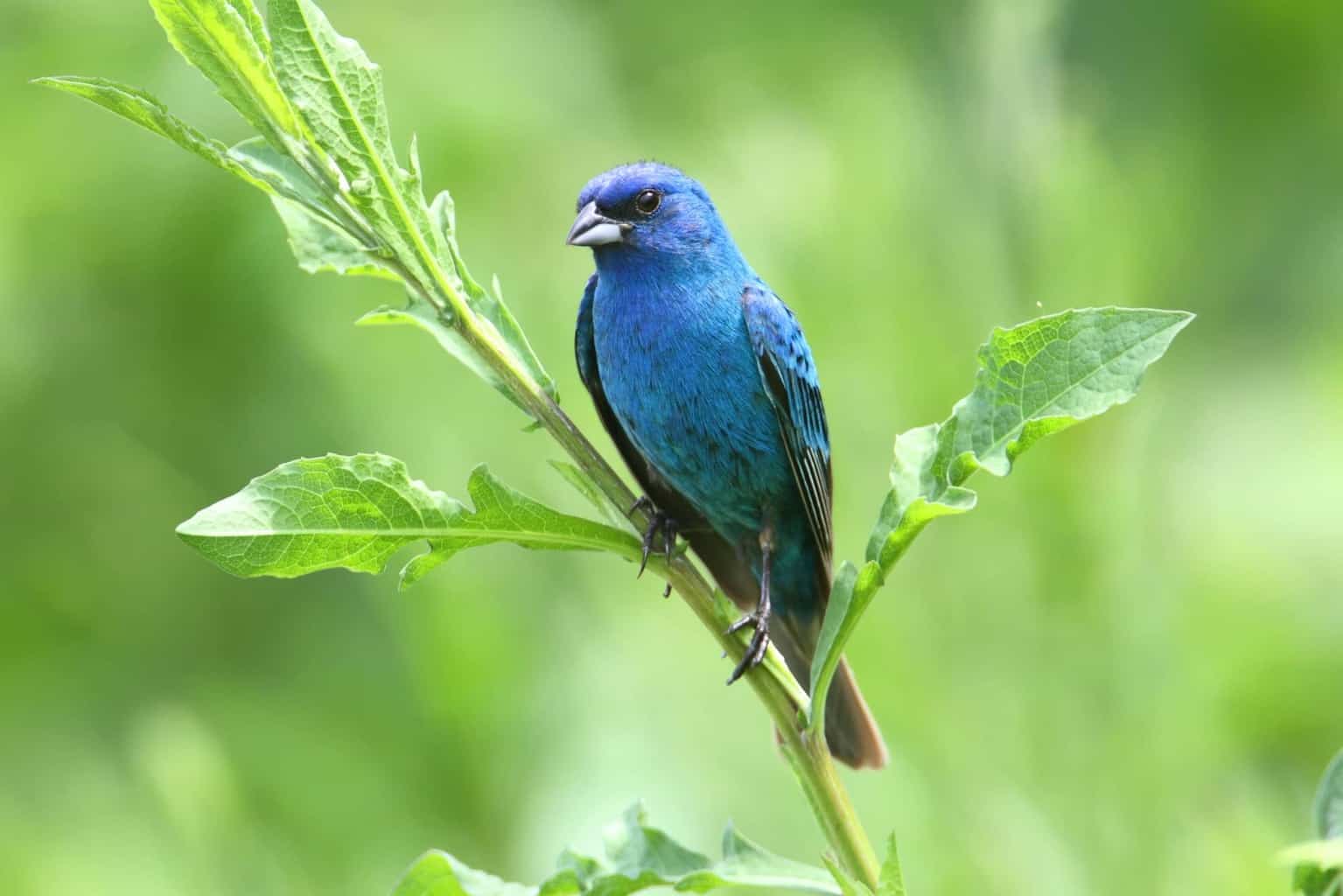
- Scientific name: Passerina cyanea
- Length: 4.7 – 5.1 inches
- Weight: 0.4 – 0.6 ounce
- Wingspan: 7.5 – 8.7 inches
The Indigo bunting is pretty rare to see in Vermont. This migratory bird stays in the eastern half of the United States during the summer, then moves further south to Mexico for the winter.
Indigo buntings have a distinctive coloring that’s hard to mistake. The breeding males have bright blue bodies with richer hues on the head. On the other hand, the females and immature males are brown with faded streaks of blue on the wings or tails. They also have white throats.
While seeing an Indigo bunting is quite challenging, you may have a better chance of witnessing one if you know where to look. Search for this exquisite bird in heavily wooded areas, fields, hedgerows, and overgrown patches.
The Indigo bunting likes to feed on bugs, berries, and seeds. So, you should consider filling your bird feeder with nyjer seed or thistle in the hope that these delicious treats may attract a bird.
Green Birds in Vermont
Acadian Flycatcher
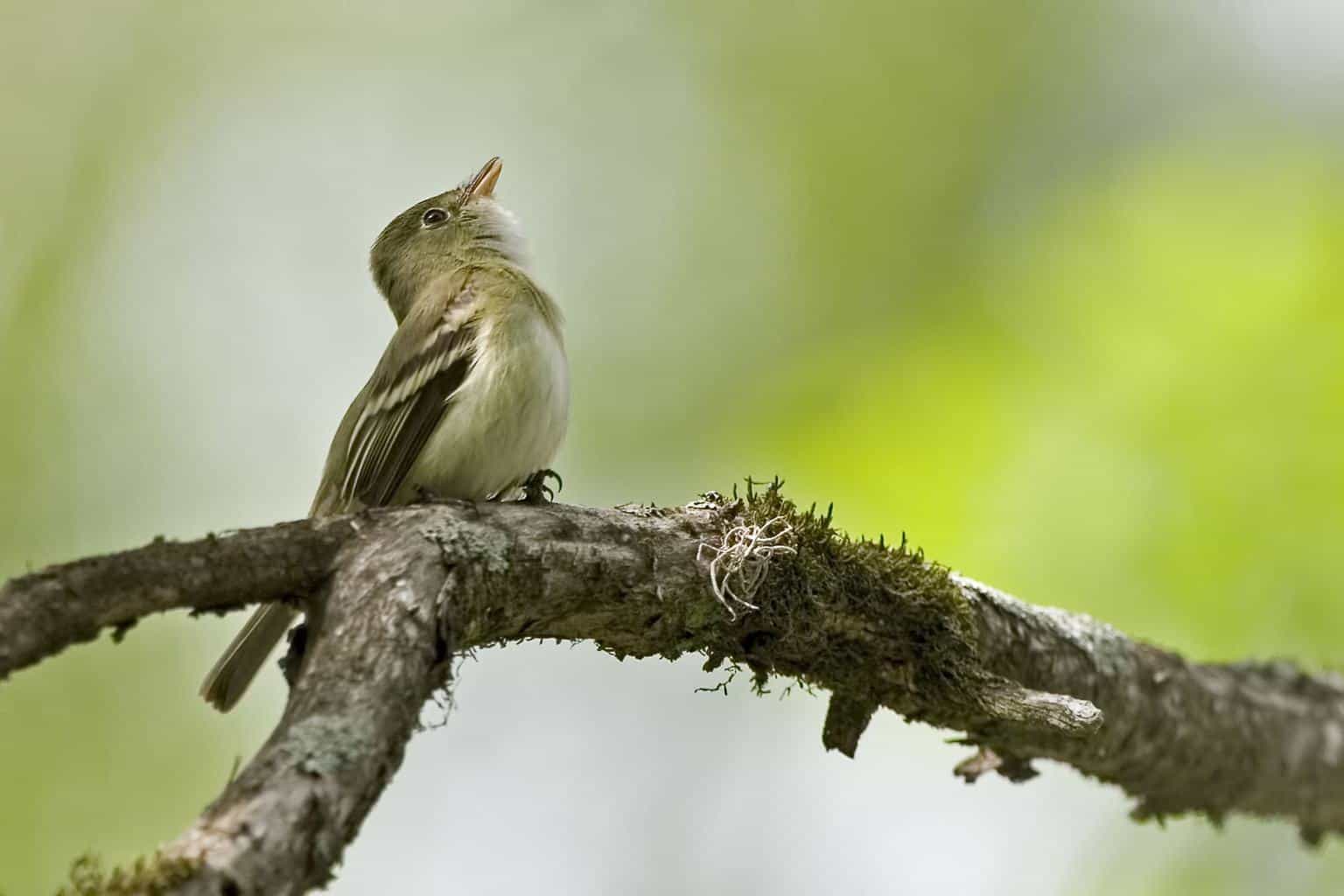
- Scientific name:Empidonax virescens
- Length: 5.5 – 5.9 inches
- Weight: 0.4 – 0.5 ounce
- Wingspan: 8.7 – 9.1 inches
Sadly, there aren’t many green bird species in Vermont. Yet, the Acadian flycatcher is a good example of one, although its feathers are rather olive-green. This tiny bird has a stocky body, a peaked head, and a flat bill.
The Acadian flycatcher isn’t exactly the most common bird in Vermont. It has much more frequent sightings in New York and Massachusetts. However, you could still witness one if you look in the forest, especially somewhere close to a body of water.
As the name suggests, the Acadian flycatcher is skilled in catching insects from the air. It also likes to snatch bugs from the undersides of leaves.
Ruby-throated Hummingbird
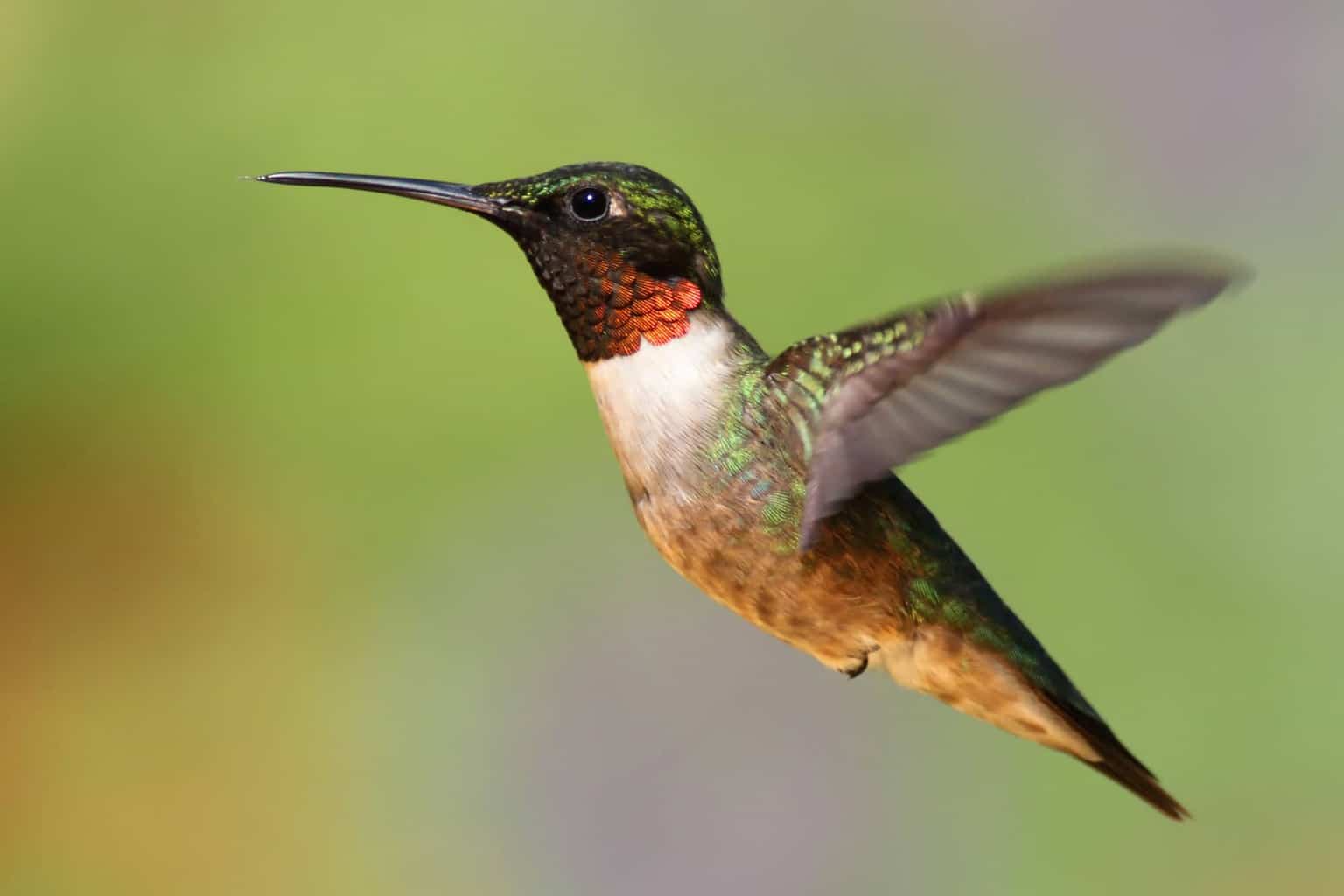
- Scientific name: Archilochus colubris
- Length: 2.8 – 3.5 inches
- Weight: 0.1 – 0.2 ounce
- Wingspan: 3.1 – 4.3 inches
The Ruby-throated hummingbird is one of the most fascinating birds that you can find in eastern North America. In fact, it’s the only breeding hummingbird that lives in this region. However, it doesn’t stay in Vermont long because it leaves for Central America by early fall.
Ruby-throated hummingbirds are known for their emerald green backs, bright red throats, and tiny bodies. They have impressively long bills and wings, which are other telltale markers of these pretty birds.
It’s a joy to watch a Ruby-throated hummingbird’s flight pattern. This bird tends to fly straight, stop suddenly, then adjust its position and direction with maximum control. It’ll use its long, sharp bill to pluck insects from midair or drink nectar from tube-shaped flowers.
Orange Birds in Vermont
Baltimore Oriole

- Scientific name: Icterus galbula
- Length: 6.7 – 7.5 inches
- Weight: 1.1 – 1.4 ounces
- Wingspan: 9.1 – 11.8 inches
Here’s another eye-catching bird you can see in Vermont with the return of spring. The Baltimore oriole is a breeze to recognize thanks to its bright orange underside, black-and-white wings, and black head. The females tend to be duller in color, and they don’t have black heads.
The good news is that it isn’t hard to stumble upon the Baltimore oriole in Vermont. This bird likes to perch on treetops in open woodlands, riverbanks, and the edges of swamps. You don’t have to go deep into dark forests to see one.
Even better, attracting a Baltimore oriole to your yard is simple. Just keep some ripe fruit and jelly available for this bird to feed on. These sugary treats provide much-needed energy, while the insects that the oriole eats give it proper nutrition.
Yellow Birds in Vermont
American Goldfinch
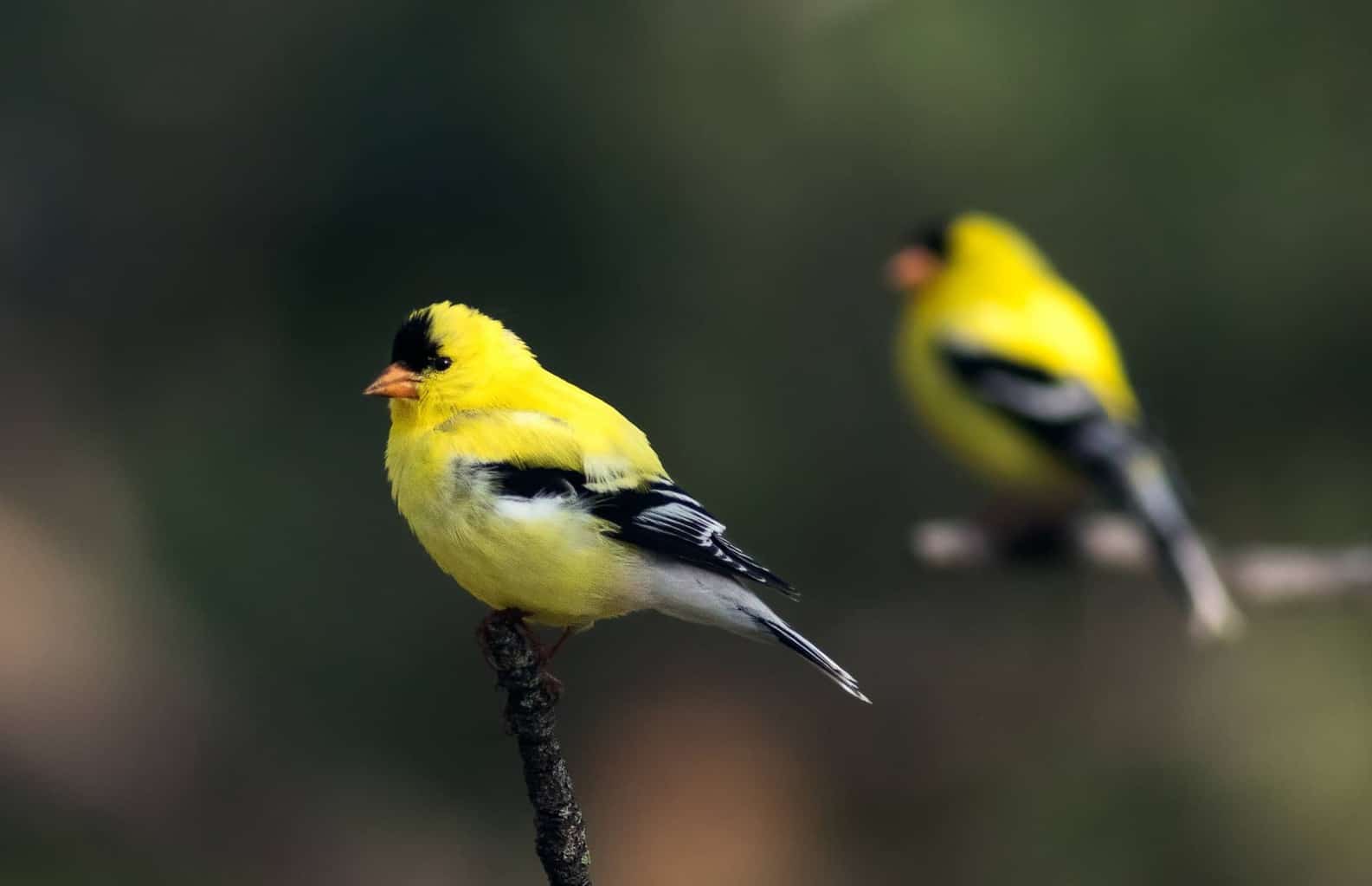
- Scientific name: Spinus tristis
- Length: 4.3 – 5.1 inches
- Weight: 0.4 – 0.7 ounce
- Wingspan: 7.5 – 8.7 inches
Colloquially called a “wild canary,” the American goldfinch has bright yellow plumage that anyone can recognize. This little bird has a big fanbase in Vermont; yearly sightings of it account for around 34% of all bird species.
The American goldfinch has a plump body with a relatively large head and a short tail. The bill is usually short and pinkish. While the males are yellow in the summer and grayish-yellow in winter, the females are dull olive.
American goldfinches live in weedy fields and clearings. They like to stay close to thistles and similar plants, so you could attract them to your yard by installing a thistle sock. Fill this bird feeder with nyjer, weed, or sunflower seeds.
Yellow-breasted Chat
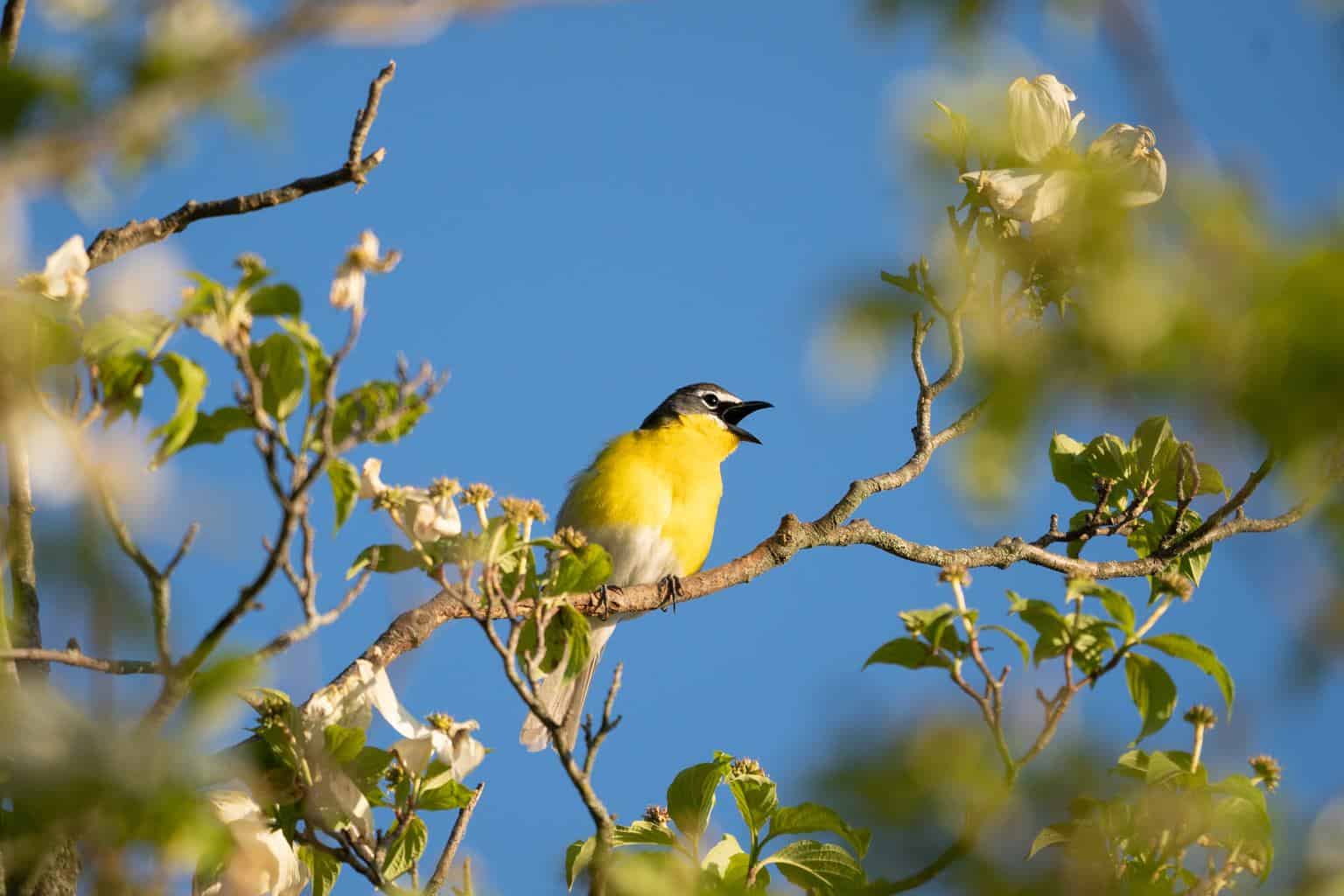
- Scientific name: Icteria virens
- Length: 17.1 inches
- Weight: 0.8 – 1.1 ounces
- Wingspan: 9.8 inches
The Yellow-breasted chat is a medium-sized bird that you can see in Vermont. Despite being widespread across the entire country, this bird is not easily spotted. This is because the Yellow-breasted chat lives in dense thickets and heavily shrubby areas.
Still, you may hear the males sing in the breeding season, hoping to attract females. These birds sometimes perch on high branches in plain sight to showcase their singing talents. They might also perform impressive flight displays.
A Yellow-breasted chat’s diet primarily consists of insects. It’ll occasionally feed on small fruits, too.
Connecticut Warbler

- Scientific name: Oporornis agilis
- Length: 5.1 – 5.9 inches
- Weight: 0.5 ounce
- Wingspan: 8.7 – 9.4 inches
Although there have been sightings of it in the last few years, the Connecticut warbler is one of the rarest birds in the United States.
This bird is pretty easy to tell apart. People identify it by its yellow belly, gray hood, and bold white eyering. The females and younglings appear in more faded colors and sometimes lean toward a brownish hue.
Unlike other bird species that hop, the Connecticut warbler walks on low branches or the ground. This way, it’s much more convenient to forage for invertebrates in places with heavy undergrowth.
Kentucky Warbler
- Scientific name: Geothlypis formosa
- Length: 5.1 inches
- Weight: 0.5 ounce
- Wingspan: 7.9-8.7 inches
The Kentucky warbler is another bird that’s quite rare to see in Vermont. Generally, this bird’s population has declined over the last few decades because more and more forests are being destroyed.
Kentucky warblers are known for their brilliant yellow color, which is brighter around the underside. The wings are duller, bordering on brownish olive.
This bird lives deep within forests, so you may need to take a serious hike to find one. The best time of the day to look for a Kentucky warbler is early in the morning. Once you do that, listen for the distinctively loud male songs.
Other Birds to Watch For in Vermont
As you’ve noticed, Vermont is rich in colorful birds varying in size, behavior, and eating habits. However, this state has an even larger variety of birds of other colors, including black, gray, brown, etc.
Let’s take a look at these fascinating creatures!
Black-capped Chickadee

- Scientific name: Poecile atricapillus
- Length: 4.7 – 5.9 inches
- Weight: 0.3 – 0.5 ounce
- Wingspan: 6.3 – 8.3 inches
The Black-capped chickadee is a permanent resident of Vermont, with 40% sighting frequency in summer and 57% in winter. This bird is a common backyard visitor, so it shouldn’t be surprising to find several at your feeder daily.
The Black-capped chickadee is simple to identify. It has a small, round body, a big, round head, and a short straight bill. Plus, the upper part of its body, the head, and the bib is black. There are also white edges on the feathers.
Black-capped chickadees will eat a wide range of things, including insects, seeds, and berries.
Mourning Dove

- Scientific name: Zenaida macroura
- Length: 9.1 – 13.4 inches
- Weight: 3.4 – 6.0 ounces
- Wingspan: 17.7 inches
Mourning doves are widespread across the nation, so it’s only natural to find them in abundance in Vermont. Usually, when anyone talks about doves, this type of dove will be at the forefront of their minds.
Mourning doves are easily recognizable by their brownish bodies, which are very plump. The heads are round and much smaller than the bodies. As for the tails, they’re long and pointed.
Better still, Mourning doves don’t mind spending their time in urban areas. They also like to stay in the woods and forests. To attract them to your backyard, use sunflower seeds.
Downy Woodpecker
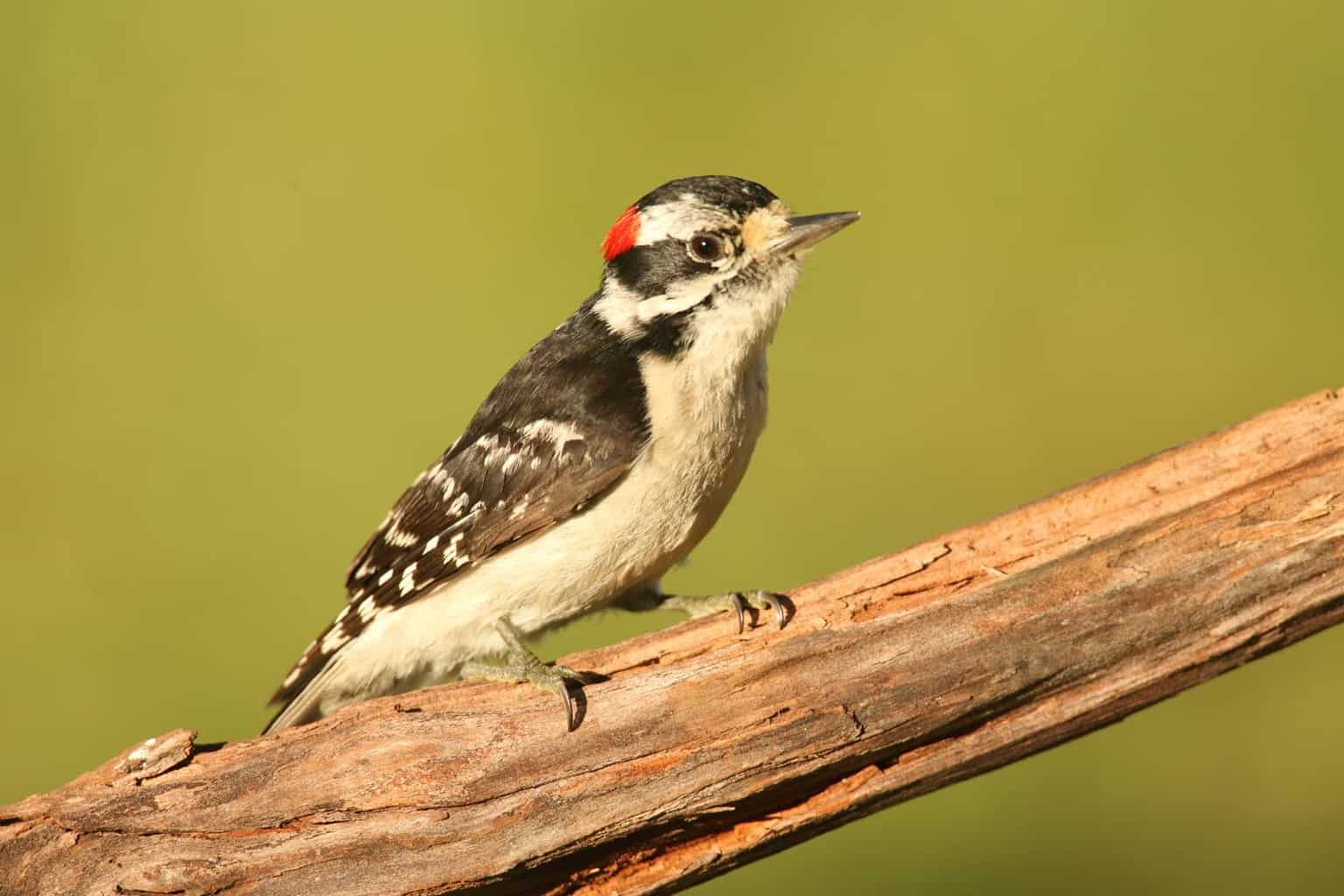
- Scientific name: Dryobates pubescens
- Length: 5.5 – 6.7 inches
- Weight: 0.7 – 1.0 ounce
- Wingspan: 9.8 – 11.8 inches
Downy woodpeckers are common in North America, and they’re the tiniest out of all woodpeckers in the country. To identify a Downy woodpecker, look for a black-and-white striped head, white underparts, and a red spot on the back of the head.
These woodpeckers are usually found in small deciduous trees near the water. While the males prefer to perch on smaller plants, the females like to shoot for tree trunks.
Downy woodpeckers will eat insects, seeds, fruits, acorns, and more.
American Crow

- Scientific name: Corvus brachyrhynchos
- Length: 15.8 – 20.9 inches
- Weight: 11.2 – 21.9 ounces
- Wingspan: 33.5 – 39.4 inches
With its shiny black feathers and large body, it’s impossible to miss the American crow. The feathers, bill, and legs are all black. The American crow lives throughout the United States, with a sighting percentage of 42% in Vermont.
Besides the distinctive coloring, this crow’s caw is familiar to almost everyone. You can easily witness the bird in open areas with trees, farms, cities, and fields.
The American crow’s diet is flexible since the bird is omnivorous. It’ll eat small mammals, insects, carrion, and grain. If you want it to stay away from your yard, try not to leave any table scraps in your feeder.
Song Sparrow
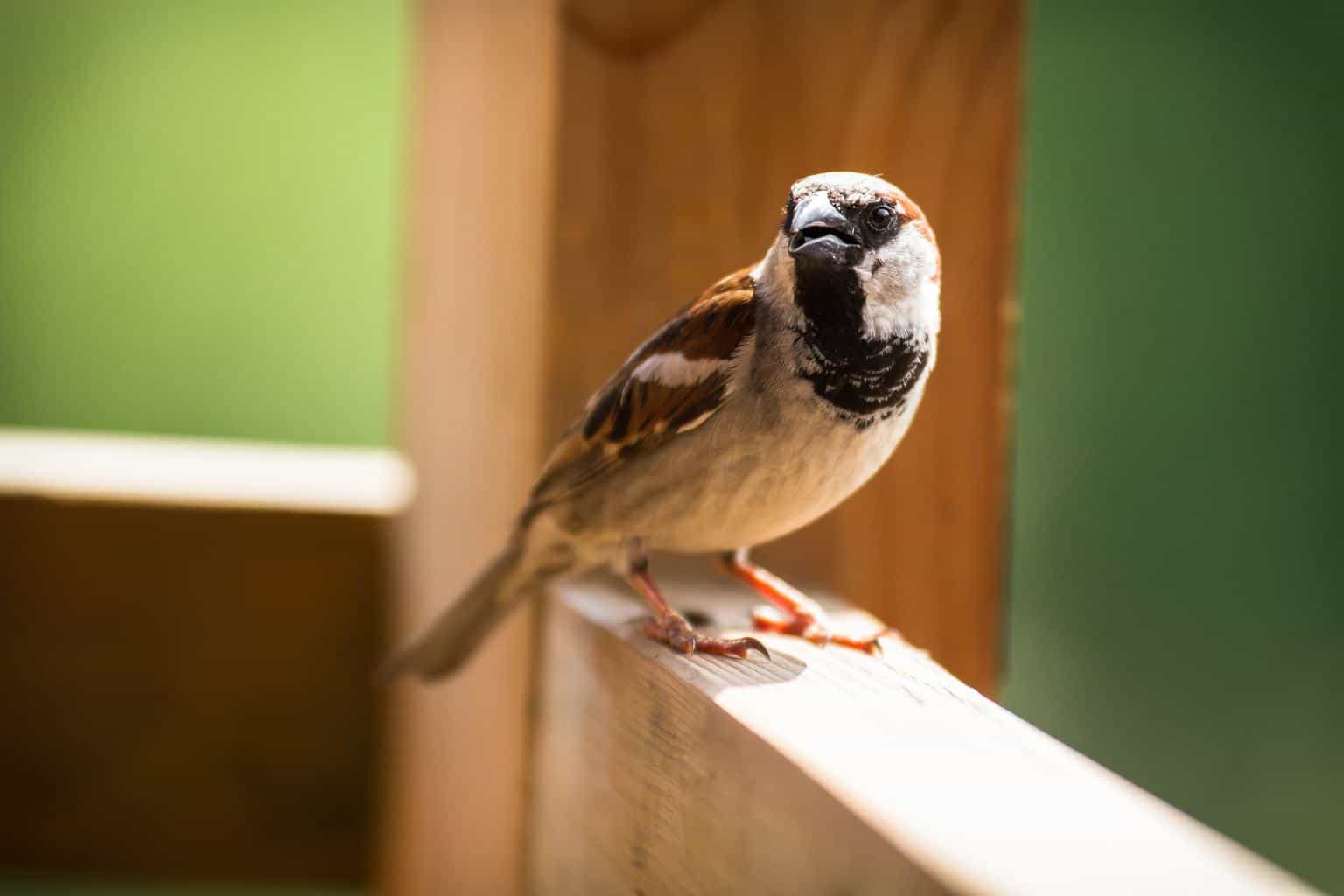
- Scientific name:Melospiza melodia
- Length: 4.7 – 6.7 inches
- Weight: 0.4 – 1.9 ounces
- Wingspan: 7.1 – 9.4 inches
Song sparrows are common in Vermont, especially near thickets and bodies of water. You might also see one close to your backyard shrubbery.
These little birds have plump bodies, small bills, and round heads. They’re hugely variable in color combinations, ranging from dark rusty to pale gray. Their feathers have complex patterns with streaks on the sides.
Song sparrows like to stick to low branches and low vegetation. These locations allow them to look for bugs on the ground. Then, when done hunting, they’ll fly to higher branches.
You can attract a Song sparrow to your yard by providing mixed bird seeds. Also, ground insects might draw the bird’s attention to your lawn.
To Wrap It Up
Birds in Vermont come in all sorts of colors, shapes, sizes, and characteristics. Some are tiny but fierce, while others are big and mild-tempered. Watching these various personalities can be the best thing to do on a weekend if you’re a hardcore bird-watcher.
Luckily, it’s always easy to spot common birds in Vermont. They can come of their own accord to your yard if you offer them their favorite seeds.
Some bird species don’t like mingling with the human populace and may be a bit harder to see. Still, a careful hike in the forest, keen eyes and ears, and knowing just where to look should be effective in finding that rare bird!

